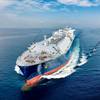Cargo Growth at Indian Ports Remain Sluggish
In FY14, total cargo handled at Indian ports increased by 4.3% to 976 million tonnes from 935 million tonnes during FY13. The growth was pegged down by sluggish cargo performance at the major ports which registered a meagre 1.8% growth in cargo volumes to 556 million tonnes in FY14.
Non major ports on the other hand exceeded the overall growth rate by recording an 8.3% growth in throughput on a yoy basis to 420 million tonnes. While the growth was meagre, on a positive note the major ports arrested the decline in cargo volumes to register the first increase in yoy cargo throughput since FY11. During the first four months of FY15, the cargo throughput at major ports has registered a modest 3.3% growth over the corresponding period of previous year.
According to Mr. K. Ravichandran, Senior Vice-President and Co-Head, Corporate Ratings, ICRA, “The growth at major ports during FY14 was pegged down by a further decline in iron-ore cargo volumes following mining restrictions in major states like Karnataka; Goa and Orissa and other policy related uncertainties like imposition of export duty. Lower container and fertilizer volumes also pegged down growth at major ports. These declines were offset by healthy growth in coal imports, which along with stable volumes in other bulk cargoes (solid and liquid) supported the modest growth registered. In terms of market share, non major ports continue to increase their market share – to about 43% of total cargo in FY14 as against 42% in FY13. The consistently superior performance of the non major ports (cargo share has increased significantly from 29% over FY 07-FY 14) may be attributed to their better cargo handling infrastructure and facilities vis-à-vis the major ports; more diversified cargo mix and presence of group captive cargo in some cases.”
ICRA Research notes that the growth during the first four months of FY15, was supported by an increase in all cargoes except POL (-0.5%) and Iron Ore (-7.5%), at all ports. Coal volume growth however, remained significantly lower than overall growth in FY 14 at 1.1%, while other cargo, Containers and FRM registered growth of 10.8%, 5.33% and 24.7% respectively. At JNPT and Chennai (which handle the majority of the container cargo at major ports) the increase in container volumes was moderate, with 4.8% and 4.2% increase in volumes respectively. New Mangalore (-3.7%) and Kolkata (-6.9%) reported volume decline during the period, while Mormugao (26.8%), Kamarajar (Ennore, 16.7%) and Tuticorin (11.7%) reported the highest cargo growth rates. Comparatively lower coal volumes compared to previous quarters, affected the volumes of major bulk handling ports like Paradip, New Mangalore, Vizag and Haldia (Kolkata).
The 2014-15 budget provides a thrust on reviving investments in the port sector, with a significant increase in outlay on setting up of greenfield ports, development of SEZs at existing ports, setting up of a single window for custom clearance, etc.
With respect to these new announcements, Mr. K Ravichandran mentioned “ICRA Research notes that the budget, proposes to set up an institutional body – ‘3P India’, which could address some of the obstacles faced by port developers operating through the PPP route and support the developers in obtaining regulatory approvals and speedy resolution of pending issues. Along with the constitution of this institution, the proposed large investments in the sector on new capacity additions, recent guidelines by MoS on Land Policy for Major Ports, plans for establishing a mechanism to re-negotiate terms of the PPP projects as well as to redefine the role of the port tariff regulator and to deregulate tariff setting at the 12 major ports, are all expected to provide major impetus to growth in the sector and could boost trade movement at Indian ports in the long term.”
ICRA Research notes that the cargo growth outlook for the Indian port sector continues to be strong over the medium to long term driven by the domestic requirements of coal, for power and other sectors; crude oil, for meeting domestic petroleum requirements; and containers, given the cost and logistical advantages associated with containerization. Some near term uncertainty may, however, be associated with particular cargo categories like imported coal, due to uncertainties plaguing the power sector and persisting delays in execution of greenfield power projects; iron ore, due to unresolved policy issues; and containers, due to the weak global environment affecting exim trade. Further, the resolution of the ongoing tariff policy related discussions to bring clarity on the tariffs going forward as well as actual materialization of projects awarded by the Ministry of Shipping, Government of India, would be crucial for the long term cargo growth prospects at the major ports.
icraindia.com










